ACPI
SSDT-PLUG.aml
SSDT-EC-USBX.ami
SSDT-AWAC.ami
SSDT-PMC.aml
SSDT-UIAC.aml
Drivers
OpenRuntime.efi
のみを残す。
Kext
AppleALC.kext
Lilu.kext
RealtekRTL8111.kext
SMCBatteryManager.kext(あとでDisableに)
SMCLightSensor.kext(あとでDisableに)
SMCProcessor.kext
SMCSuperIO.kext
USBInjectAll.kext
VirtualSMC.kext
WhateverGreen.kext
Tools
後で
OpenShell.efi
のみをEnableにする。
Finderで/Volumes/をよく使う項目にセット
ProperTree.commandを起動
Sample.plist→config.plistへ
ProperTree.commandでOpen
OC Clean SnapshotでOCを選択→自動でaml,Kext,efiが入る
上に従い、aml,Kext,efiを設定
以下config.plist設定
●ACPI
Block
This blocks certain ACPI tables from loading, for us we can ignore this
Patch:
This section allows us to dynamically modify parts of the ACPI (DSDT, SSDT, etc.) via OpenCore. For us, our patches are handled by our SSDTs. This is a much cleaner solution as this will allow us to boot Windows and other OSes with OpenCore
Quirk:
Settings relating to ACPI, leave everything here as default.
*FadtEnableReset: NO
Enable reboot and shutdown on legacy hardware, not recommended unless needed
*NormalizeHeaders: NO
Cleanup ACPI header fields, only relevant for macOS High Sierra 10.13
*RebaseRegions: NO
Attempt to heuristically relocate ACPI memory regions, not needed unless custom DSDT is used.
*ResetHwSig: NO
Needed for hardware that fails to maintain hardware signature across the reboots and cause issues with waking from hibernation
*ResetLogoStatus: NO
Workaround for OEM Windows logo not drawing on systems with BGRT tables.
●Booter
This section is dedicated to quirks relating to boot.efi patching with OpenRuntime, the replacement for AptioMemoryFix.efi
MmioWhitelist:
This section is allowing devices to be passthrough to macOS that are generally ignored, for us we can ignore this section.
Quirks:
Settings relating to boot.efi patching and firmware fixes, ones we need to change are DevirtualiseMmio, RebuildAppleMemoryMap, SyncRuntimePermissions and SetupVirtualMap
*AvoidRuntimeDefrag: YES
Fixes UEFI runtime services like date, time, NVRAM, power control, etc
@DevirtualiseMmio: YES
Reduces Stolen Memory Footprint, expands options for slide=N values and very helpful with fixing Memory Allocation issues on Z390. Requires ProtectUefiServices as well on IceLake and Z390 Coffee Lake
*DisableSingleUser: NO
Disables the use of Cmd+S and -s, this is closer to the behavior of T2 based machines
*DisableVariableWrite: NO
Needed for systems with non-functioning NVRAM, you can verify here if yours works
*DiscardHibernateMap: NO
Reuse original hibernate memory map, only needed for certain legacy hardware
*EnableSafeModeSlide: YES
Allows for slide values to be used in Safe mode
*EnableWriteUnprotector: YES
Removes write protection from CR0 register during their execution
*ForceExitBootServices: NO
Ensures ExitBootServices calls succeeds even when the Memory Map has changed, don't use unless necessary
*ProtectMemoryRegions: NO
Needed for fixing artifacts and sleep-wake issues, generally only needed on very old firmwares
*ProtectSecureBoot: NO
Fixes Secure Boot keys on MacPro5,1 and Insyde firmwares
*ProtectUefiServices: NO
Protects UEFI services from being overridden by the firmware, mainly relevant for VMs, Icelake and Z390 systems'
If on Z390, enable this quirk
*ProvideCustomSlide: YES
If there's a conflicting slide value, this option forces macOS to use a pseudo-random value. Needed for those receiving Only N/256 slide values are usable! debug message
@RebuildAppleMemoryMap: YES
Generates Memory Map compatible with macOS, can break on some laptop OEM firmwares so if you receive early boot failures disable this
@SetupVirtualMap: NO
Fixes SetVirtualAddresses calls to virtual addresses, not needed on Skylake and newer. Some firmware like Gigabyte may still require it, and will kernel panic without this
*SignalAppleOS: NO
Tricks the hardware into thinking its always booting macOS, mainly beneficial for MacBook Pro's with dGPUs as booting Windows won't allow for the iGPU to be used
@SyncRuntimePermissions: YES
Fixes alignment with MAT tables and required to boot Windows and Linux with MAT tables, also recommended for macOS. Mainly relevant for Skylake and newer
●DeviceProperties
Add: Sets device properties from a map.
*PciRoot(0x0)/Pci(0x2,0x0) {New Chidlenで作って、Dictionaryに直す}
This section is set up via WhateverGreen's Framebuffer Patching Guide and is used for fixing certain iGPU properties like ig-platform-id. The way we get the proper value for this is to look at the framebuffer we intend to use, then swap the pairs of hex bytes.
RX-570を使っているので、ヘッドレスでAAPL,ig-platform-idを入れる
0x3E920003 - this is used when the Desktop iGPU is only used for computing tasks and doesn't drive a display
+0300923E when hex-swapped(this is the value we use for AAPL,ig-platform-id){New Childrenで作って、AAPL,ig-platform-id、Data形式で0300923Eを入れる}
●Kernel
Add: Here's where you specify which kexts to load, order matters here so make sure Lilu.kext is always first! Other higher priority kexts come after Lilu such as VirtualSMC, AppleALC, WhateverGreen, etc. A reminder that ProperTree users can run Cmd/Ctrl + Shift + R to add all their kexts in the correct order without manually typing each kext out.
BundlePath
Name of the kext
ex: Lilu.kext
Enabled
Self-explanatory, either enables or disables the kext
ExecutablePath
Path to the actual executable is hidden within the kext, you can see what path your kext has by right-clicking and selecting Show Package Contents. Generally, they'll be Contents/MacOS/Kext but some have kexts hidden within under Plugin folder. Do note that plist only kexts do not need this filled in.
ex: Contents/MacOS/Lilu
PlistPath
Path to the info.plist hidden within the kext
ex: Contents/Info.plist
以上はOC Clean Snapshotで設定済みになる
Emulate: Needed for spoofing unsupported CPUs like Pentiums and Celerons
CpuidMask: Leave this blank
CpuidData: Leave this blank
Block: Blocks kexts from loading. Not relevant for us
Patch: Patches both the kernel and kexts
Quirks:
Settings relating to the kernel, for us we'll be enabling AppleCpuPmCfgLock, AppleXcpmCfgLock, DisableIOMapper, PanicNoKextDump, PowerTimeoutKernelPanic and XhciPortLimit. Everything else should be left as default
@AppleCpuPmCfgLock: YES
Only needed when CFG-Lock can't be disabled in BIOS, Clover counterpart would be AppleIntelCPUPM. Please verify you can disable CFG-Lock, most systems won't boot with it on so requiring use of this quirk
@AppleXcpmCfgLock: YES
Only needed when CFG-Lock can't be disabled in BIOS, Clover counterpart would be KernelPM. Please verify you can disable CFG-Lock, most systems won't boot with it on so requiring use of this quirk
*AppleXcpmExtraMsrs: NO
Disables multiple MSR access needed for unsupported CPUs like Pentiums and many Xeons.
*AppleXcpmForceBoost: NO
Forces maximum multiplier, only recommended to enable on scientific or media calculation machines that are constantly under load. Main Xeons benefit from this
*CustomSMBIOSGuid: NO
Performs GUID patching for UpdateSMBIOSMode Custom mode. Usually relevant for Dell laptops
@DisableIoMapper: YES
Needed to get around VT-D if either unable to disable in BIOS or needed for other operating systems, much better alternative to dart=0 as SIP can stay on in Catalina
@DisableRtcChecksum: YES
Prevents AppleRTC from writing to primary checksum (0x58-0x59), required for users who either receive BIOS reset or are sent into Safe mode after reboot/shutdown
*DummyPowerManagement: NO
New alternative to NullCPUPowerManagement, required for all AMD CPU based systems as there's no native power management. Intel can ignore
*ExternalDiskIcons: NO
External Icons Patch, for when internal drives are treated as external drives but can also make USB drives internal. For NVMe on Z87 and below you just add built-in property via DeviceProperties.
*IncreasePciBarSize: NO
Increases 32-bit PCI bar size in IOPCIFamily from 1 to 4 GB, enabling Above4GDecoding in the BIOS is a much cleaner and safer approach. Some X99 boards may require this, you'll generally experience a kernel panic on IOPCIFamily if you need this. Note this shouldn't be needed on Mojave and newer
*LapicKernelPanic: NO
Disables kernel panic on AP core lapic interrupt, generally needed for HP systems. Clover equivalent is Kernel LAPIC
@PanicNoKextDump: YES
Allows for reading kernel panics logs when kernel panics occur
@PowerTimeoutKernelPanic: YES
Helps fix kernel panics relating to power changes with Apple drivers in macOS Catalina, most notably with digital audio.
@ThirdPartyDrives: YES
Enables TRIM, not needed for NVMe but AHCI based drives may require this. Please check under system report to see if your drive supports TRIM
*XhciPortLimit: YES
This is actually the 15 port limit patch, don't rely on it as it's not a guaranteed solution for fixing USB. Please create a USB map when possible.
Misc
Boot: Settings for boot screen (Leave everything as default)
*HibernateMode: None
Best to avoid hibernation with Hackintoshes all together
*PickerMode: Builtin
Sets OpenCore to use the builtin picker
*HideAuxiliary: NO
Hides Recovery and other partitions unless spacebar is pressed, more closely matches real Mac behavior
*HideSelf: YES
Hides the EFI partition as a boot option in OC's boot picker
*ConsoleAttributes: 0
Sets OpenCore's UI color, won't be covered here but see 8.3.8 of Configuration.pdf for more info
*PickerAttributes: 0
Used for setting custom picker attributes, use of this setting will be covered in Post-Install
*PickerAudioAssist: NO
Used for enabling VoiceOver like support in the picker, unless you want your hack talking to you keep this disabled
*PollAppleHotKeys: NO
Allows you to use Apple's hotkeys during boot, depending on the firmware you may need to use OpenUsbKbDxe.efi instead of OpenCore's builtin support. Do note that if you can select anything in OC's picker, disabling this option can help. Popular commands:
Cmd+V: Enables verbose
Cmd+Opt+P+R: Cleans NVRAM
Cmd+R: Boots Recovery partition
Cmd+S: Boot in Single-user mode
Option/Alt: Shows boot picker when ShowPicker set to NO, an alternative is ESC key
*TakeoffDelay: 0
Used to add a delay for hotkeys when OpenCore is a bit to fast to register, 5000-10000 microseconds is the preferred range for users with broken hotkeys support
*Timeout: 5
This sets how long OpenCore will wait until it automatically boots from the default selection
Debug: Helpful for debugging OpenCore boot issues(We'll be changing everything but DisplayDelay)
@AppleDebug: YES
Enables boot.efi logging, useful for debugging. Note this is only supported on 10.15.4 and newer
@DisableWatchDog: YES
Disables the UEFI watchdog, can help with early boot issues
@Target: 67
Shows more debug information, requires debug version of OpenCore
*DisplayLevel: 2147483650
Shows even more debug information, requires debug version of OpenCore
These values are based of those calculated in OpenCore debugging
Security: Security is pretty self-explanatory, do not skip
We'll be changing AllowNvramReset, AllowSetDefault, Vault and ScanPolicy
@AllowNvramReset: YES
Allows for NVRAM reset both in the boot picker and when pressing Cmd+Opt+P+R
@AllowSetDefault: YES
Allow CTRL+Enter and CTRL+Index to set default boot device in the picker
*AuthRestart: NO:
Enables Authenticated restart for FileVault 2 so password is not required on reboot. Can be considered a security risk so optional
*BootProtect: None
Allows the use of Bootstrap.efi inside EFI/OC/Bootstrap instead of BOOTx64.efi, useful for those wanting to either boot with rEFInd or avoid BOOTx64.efi overwrites from Windows. Proper use of this quirks is not be covered in this guide
*ExposeSensitiveData: 6------->15{Kext Updaterが動かない}
Shows more debug information, requires debug version of OpenCore
@Vault: Optional
We won't be dealing vaulting so we can ignore, you won't boot with this set to Secure
This is a word, it is not optional to omit this setting. You will regret it if you don't set it to Optional, note that it is case-sensitive
@ScanPolicy: 0
0 allows you to see all drives available, please refer to Security section for further details. Will not boot USB devices with this set to default
Tools Used for running OC debugging tools like the shell, ProperTree's snapshot function will add these for you. For us, we won't be using any tools
Name
Name shown in OpenCore
Enabled
Self-explanatory, enables or disables
Path
Path to file after the Tools folder
ex: OpenShell.efi
Entries: Used for specifying irregular boot paths that can't be found naturally with OpenCore
Won't be covered here, see 8.6 of Configuration.pdf for more info
●NVRAM
Add:
*4D1EDE05-38C7-4A6A-9CC6-4BCCA8B38C14 (Booter Path, mainly used for UI Scaling)
UIScale:
@01: Standard resolution(Clover equivalent is 0x28)
02: HiDPI (generally required for FileVault to function correctly on smaller displays, Clover equivalent is 0x2A)
DefaultBackgroundColor: Background color used by boot.efi
@00000000: Syrah Black
BFBFBF00: Light Gray
*7C436110-AB2A-4BBB-A880-FE41995C9F82 (System Integrity Protection bitmask)
General Purpose boot-args:
*boot-args Description
shikigva=32 shiki-id=Mac-7BA5B2D9E42DDD94(Mojaveのjpegのプレビューのため)
*csr-active-config: Settings for SIP, generally recommended to manually change this within Recovery partition with csrutil via the recovery partition
csr-active-config is set to 00000000 which enables System Integrity Protection. You can choose a number of other options to enable/disable sections of SIP. Some common ones are as follows:
00000000 - SIP completely enabled
03000000 - Allow unsigned kexts and writing to protected fs locations
E7030000 - SIP completely disabled(選択)
Recommended to leave enabled for best security practices
*prev-lang:kbd: <>
Needed for non-latin keyboards in the format of lang-COUNTRY:keyboard, recommended to keep blank though you can specify it(Default in Sample config is Russian):
American: en-US:0(656e2d55533a30 in HEX)
Full list can be found in AppleKeyboardLayouts.txt
Hint: prev-lang:kbd can be changed into a String so you can input en-US:0 directly instead of converting to HEX
Key Type Value
prev-lang:kbd String en-US:0
prev-lang:kbd String ja:0 マック互換ならこれで良いはず
Block: Forcibly rewrites NVRAM variables, do note that Add will not overwrite values already present in NVRAM so values like boot-args should be left alone.
*LegacyEnable: NO
Allows for NVRAM to be stored on nvram.plist, needed for systems without native NVRAM
*LegacyOverwrite: NO
Permits overwriting firmware variables from nvram.plist, only needed for systems without native NVRAM
LegacySchema
Used for assigning NVRAM variables, used with LegacyEnable set to YES
WriteFlash: YES
Enables writing to flash memory for all added variables.
●Pionner BD-209 patch
<key>Kernel</key>
<dict>
<key>Patch</key>
<array>
<dict>
<key>Base</key>
<string></string>
<key>Comment</key>
<string>PioneerBD-RW No Sleep</string>
<key>Count</key>
<integer>1</integer>
<key>Enabled</key>
<true/>
<key>Find</key>
<data>RFZELVJXICBEVlItMTA1</data>
<key>Identifier</key>
<string>com.apple.driver.PioneerSuperDrive</string>
<key>Limit</key>
<integer>0</integer>
<key>Mask</key>
<data></data>
<key>MaxKernel</key>
<string></string>
<key>MinKernel</key>
<string></string>
<key>Replace</key>
<data>QkQtUlcgICBCRFItMjA5</data>
<key>ReplaceMask</key>
<data></data>
<key>Skip</key>
<integer>0</integer>
</dict>
</array>
</dict>
●Platforminfo
Platform項目
CloverのSMBIOSに相当する項目ですね。機種IDは、Mojave以降はiMac19,2,
Cloverのconfig.plistからSerialNumber, BoardSerialNumber, SmUUIDをコピーして、それぞれを、
SystemSerialNumber
MLB
SystemUUID
にコピー
ROMの項目には、NICのMACアドレス
●UEFI項目
Quirksの項目のRequestBootVarFallbackをTrueに変更
●Warn:oc:setting nvram 4D1FDA02-38C7-4A6A-9CC6-4BCCA8B30102:rtc-blacklist - not found oc:nvram 4D1FDA02-38C7-4A6A-9CC6-4BCCA8B30102の設定:rtc-blacklist-not found
rtc-blacklistを消す(ProperTree-masterで)
●Windowsが立ち上がらない
Misc Boot BlessOverrideに
\EFI\Microsoft\Boot\bootmgfw.efi
を追加。
 Hackintosh
Hackintosh
ノートパソコン用に作ったEFIがまとめられました。
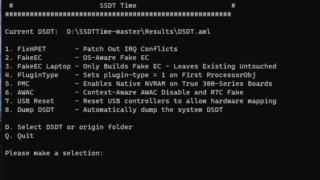
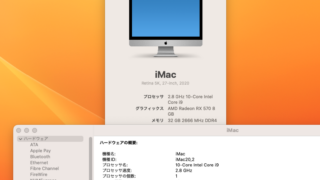
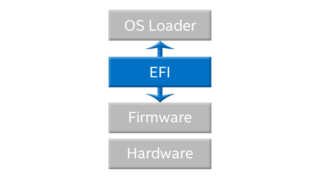
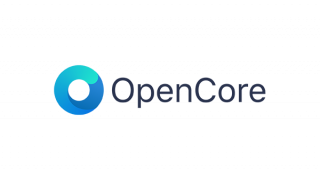
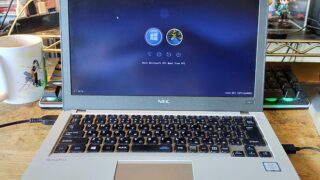




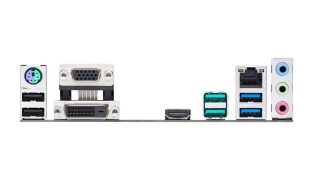
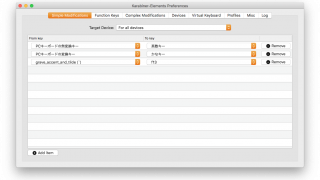
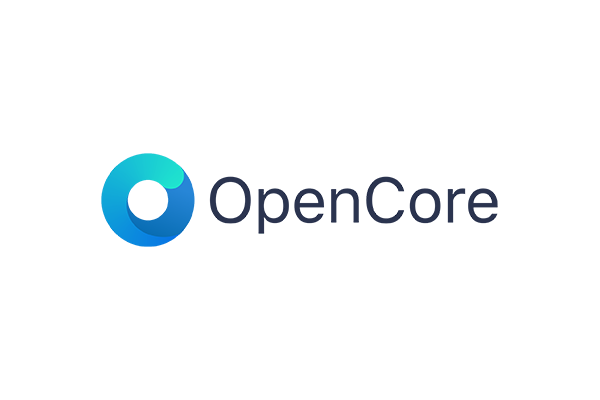

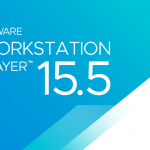
コメント